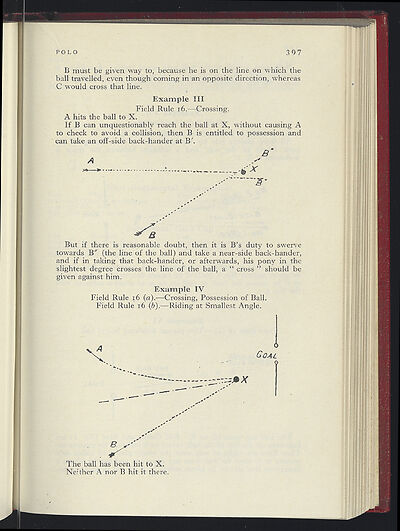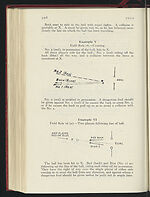1938-39
(425)
Download files
Complete book:
Individual page:
Thumbnail gallery: Grid view | List view

B must be given way to, because he is on the line on which the
ball travelled, even though coming in an opposite direction, whereas
C would cross that line.
Example III
Field Rule 16.—Crossing.
A hits the ball to X.
If B can unquestionably reach the ball at X, without causing A
to check to avoid a collision, then B is entitled to possession and
can take an off-side back-hander at B'.
But if there is reasonable doubt, then it is B's duty to swerve
towards B" (the line of the ball) and take a near-side back-hander,
and if in taking that back-hander, or afterwards, his pony in the
slightest degree crosses the line of the ball, a " cross " should be
given against him.
Example
IV
Field Rule 16 (a).—Crossing, Possession of Ball.
Field Rule 16 (b).—Riding at Smallest Angle.
The ball has been hit to X.
Neither A nor B hit it there.
ball travelled, even though coming in an opposite direction, whereas
C would cross that line.
Example III
Field Rule 16.—Crossing.
A hits the ball to X.
If B can unquestionably reach the ball at X, without causing A
to check to avoid a collision, then B is entitled to possession and
can take an off-side back-hander at B'.
But if there is reasonable doubt, then it is B's duty to swerve
towards B" (the line of the ball) and take a near-side back-hander,
and if in taking that back-hander, or afterwards, his pony in the
slightest degree crosses the line of the ball, a " cross " should be
given against him.
Example
IV
Field Rule 16 (a).—Crossing, Possession of Ball.
Field Rule 16 (b).—Riding at Smallest Angle.
The ball has been hit to X.
Neither A nor B hit it there.
Set display mode to:
![]() Universal Viewer |
Universal Viewer | ![]() Mirador |
Large image | Transcription
Mirador |
Large image | Transcription
| Games and sports in the army > 1938-39 > (425) |
|---|
| Permanent URL | https://digital.nls.uk/248742131 |
|---|
| Description | 'Games and Sports in the Army' was an annual publication produced by the British War Office between the 1930s and 1960s. This included the Second World War. It outlines the rules and regulations for games and sports played by members of the armed forces. It features names and photographs of team members, and examples of contemporary advertising. |
|---|---|
| Shelfmark | GWB.52 |

